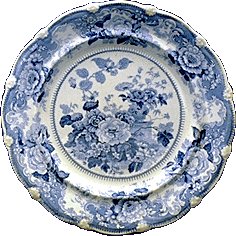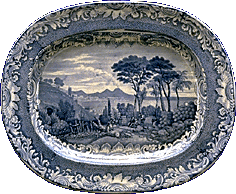 |
Plate, circa 1855 Maker: J. Goodwin, Seacombe Pottery Liverpool, England Canadian Museum of Civilization Cat. no. 979.28.3 Slide no. 17886 |
|
|
|
||
UNDERGLAZE TRANSFER-PRINTED EARTHENWAREIn the 1880s Canniff Haight, a Canadian, was describing his own generation as one that had "jumped from change to change with marvellous rapidity." The whole of the nineteenth century was a time of constant change, and any potter who wanted to stay in business had to face the challenge that change presented.When the public began to tire of earthenware that was cream in colour — as it did even before the eighteenth century was over — British potters brought out a whiter earthenware. At different periods it was produced under different names. A name first given to it in the eighteenth century, widely used today when describing it, is "pearlware."
The whiter earthenware, like the older creamware, was sometimes decorated by hand-painting. It was, however, as the background for the British-invented method of printing under the glaze on ceramic wares that it achieved its widest use. This semi-mechanical decorating technique had reached the Staffordshire earthenware potters by the 1780s. Trial and error brought it to perfection in the early nineteenth-century. Since blue was the first colour mastered for underglaze work, the whole process was termed "blue printing," even after other colours became possible.
British earthenware with underglaze-printed decoration was the most popular of all the ceramic wares used in nineteenth-century Canada, and though other colours had their day, blue was the enduring favourite. Invoices show importations before 1805; by 1811 a Halifax importer was speaking of blue-printed earthenware as "now so generally used."
The mastery of underglaze transfer printing as a means of decoration opened up endless possibilities to the potter. The British earthenware makers seized on it with such vigour that by 1809 a London publication was praising them for bringing to their country "a new source of beneficial commerce." Printed decoration was a ready means of catering to interests of the moment. Improved means of transportation available during the nineteenth century gave rise, for example, to an increasing number of travel books — and more readers of them. Potters turned this to their advantage. They ransacked travel books, looking for illustrations that could be converted to earthenware decoration: geography came to the dinner table.
Sometimes real scenes of real places were adapted; at other times potters created purely fanciful scenes, often attaching to a fanciful scene the name of an actual place. Pattern names had become important and frequently were printed on the back of the earthenware, along with the potter's name or initials.
Illustrations in popular works of literature, new or old, were another source for printed patterns. Current events, botanical works and books of natural history were additional sources. Canada was a market for all this picture-printed pottery. From a little before mid-nineteenth century, views of Canada began appearing on British earthenware. Some of these were introduced with the Canadian market in mind, but some were intended for a wider sale. Canadian scenes catered to the interest in distant lands and faraway places that was a feature of the times. To many people of the day Canada seemed a romantic land. Evidence exists to show sales of Canadian views in Great Britain itself, other parts of Europe, the United States and even Mexico. |
||||||||||||||||||||||||||||||




